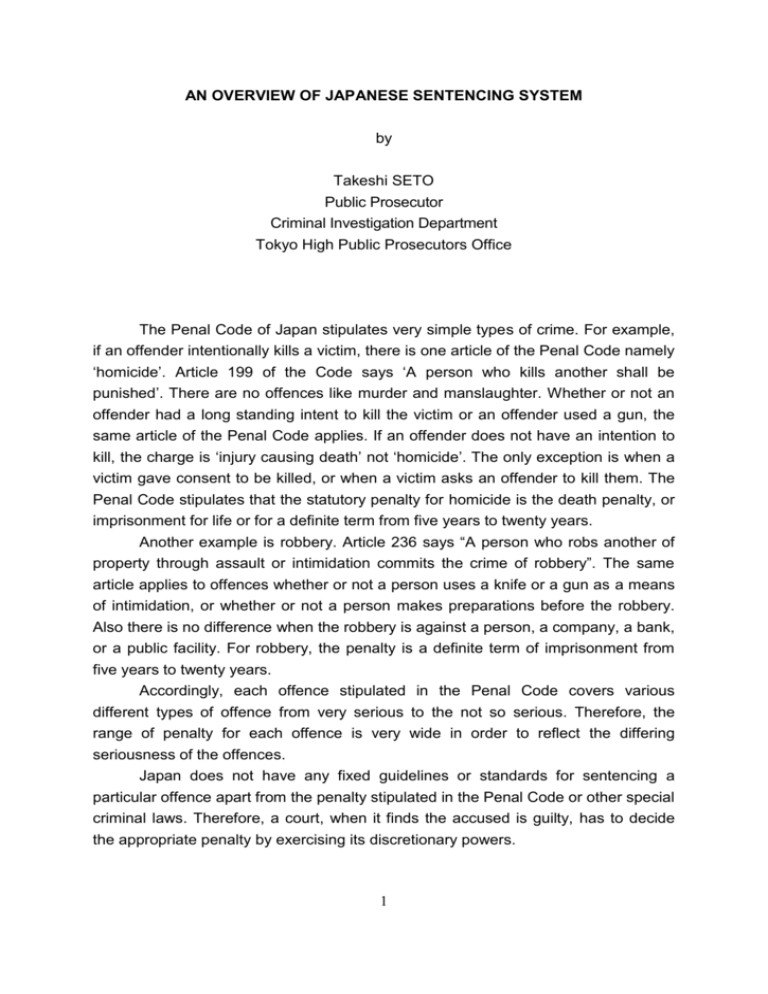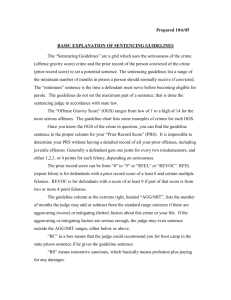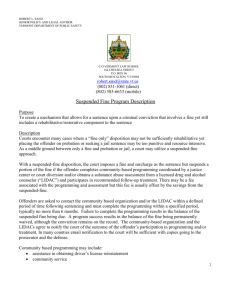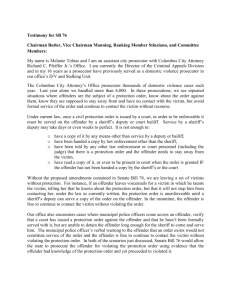
AN OVERVIEW OF JAPANESE SENTENCING SYSTEM
by
Takeshi SETO
Public Prosecutor
Criminal Investigation Department
Tokyo High Public Prosecutors Office
The Penal Code of Japan stipulates very simple types of crime. For example,
if an offender intentionally kills a victim, there is one article of the Penal Code namely
‘homicide’. Article 199 of the Code says ‘A person who kills another shall be
punished’. There are no offences like murder and manslaughter. Whether or not an
offender had a long standing intent to kill the victim or an offender used a gun, the
same article of the Penal Code applies. If an offender does not have an intention to
kill, the charge is ‘injury causing death’ not ‘homicide’. The only exception is when a
victim gave consent to be killed, or when a victim asks an offender to kill them. The
Penal Code stipulates that the statutory penalty for homicide is the death penalty, or
imprisonment for life or for a definite term from five years to twenty years.
Another example is robbery. Article 236 says “A person who robs another of
property through assault or intimidation commits the crime of robbery”. The same
article applies to offences whether or not a person uses a knife or a gun as a means
of intimidation, or whether or not a person makes preparations before the robbery.
Also there is no difference when the robbery is against a person, a company, a bank,
or a public facility. For robbery, the penalty is a definite term of imprisonment from
five years to twenty years.
Accordingly, each offence stipulated in the Penal Code covers various
different types of offence from very serious to the not so serious. Therefore, the
range of penalty for each offence is very wide in order to reflect the differing
seriousness of the offences.
Japan does not have any fixed guidelines or standards for sentencing a
particular offence apart from the penalty stipulated in the Penal Code or other special
criminal laws. Therefore, a court, when it finds the accused is guilty, has to decide
the appropriate penalty by exercising its discretionary powers.
1
No prosecution
A public prosecutor in Japan has discretion not to prosecute a case, even
though the evidence is sufficient to secure a conviction. This system can be
recognized as one of the safety measures. Article 248 of the Code guides a public
prosecutor through the exercise of his or her discretionary power of non-prosecution.
Article 248 explains “Where prosecution is deemed unnecessary owing to the
character, age or environment of the offender, gravity of the offense, circumstances
or situation after the offense, prosecution need not be initiated.” These elements can,
however, also guide a court to find aggravating and mitigating factors in sentencing.
So the list includes three parts: offender, crime and other factors.
The Standard of Proof for Sentencing
As in other countries, the standard of proof for conviction is “beyond
reasonable doubt”. However, it is not necessary that aggravating and mitigating
factors are proved to the same standard. Further the admissibility rules, which apply
to the evidence for conviction, do not apply to the evidence which relates only to
aggravating and mitigating factors.
Unlike the Anglo-American legal system, which has two separate stages for
adjudication, namely conviction and sentence, Japan combines these two stages
into one, like the systems in Continental Europe. So Japan does not have a special
procedure for finding or gathering elements for sentencing, after conviction.
Therefore, the court examines evidence to prove guilt and to determine the
appropriate sentence during the same trial procedure. So the crucial elements for
deciding sentence are included in evidence for the conviction. By reason of this,
evidence concerning aggravating and mitigating factors is usually dealt with in the
same manner as other fact-finding evidence. Although the court does not use the
same standards applied for convictions, it uses nearly the same standards.
AGGRAVATING AND MITIGATING FACTORS
The seriousness of the offence is assessed by factors which include:
the motivation or purpose of offence,
the planning,
the number of victims,
the cruelty of the crime,
the extent of injuries,
2
the amount of financial damage etc.
the possibility of copy-cat crime and
the harmful effect to local residence or society.
These are evaluations on crime itself and closely relate to retributive aspect in
sentencing. The court focuses on the offender with the focus on rehabilitation.
Examples
For example, if the character of an offender charged with assault, is
aggressive, a court may consider him or her to be a dangerous person and find a
high risk of reoffending. Similarly, principles apply when the thief is considered to be
lazy or chooses or is forced to leave his or her job. Young offenders are usually
regarded as amenable to rehabilitating and presumed not to re-offend again.
Environmental factors of the offender which are considered include whether he or
she has a family or a supervisor, or whether he or she has a steady job.
Other factors include apologies to the victim; the recovery of damage; the
possibility of a settlement out of court; remorse; recidivism by an offender; the
criminal history of the offender; participation in a criminal organisation, the
relationship with other offenders and co-operation with the investigating authorities.
Alcohol
If the offender commits a crime under the influence of alcohol and he or she
could easily have avoided such a situation by managing how to drink alcohol, this
fact may lead to more severe sentences. However it may not be a crucial element for
sentencing. In practice, the defence side usually raise this factor to plead insanity or
diminished capacity of the offender, by which the offender is not punishable or the
statutory penalty can be reduced. However such claims are rarely accepted by a
court.
Sexual abuse of children
In Japan, if a person commits sexual intercourse or other indecent acts with a
person under thirteen years old, he or she is charged with rape or other sex offences
even though the victim gives their ‘consent’. The range of statutory penalties are the
same for victims aged under thirteen and those aged thirteen or over. Where victims
are particularly young so they cannot easily recover from their trauma and the
suffering there is harsh punishment.
REDUCING SENTENCES
3
The Penal Code permits reductions from statutory maximum penalties, if one
of the conditions in the code is found. These conditions include:
a) diminished capacity of an offender,
b) voluntary abandonment of commission of the crime,
c) the offender is an accomplice who is therefore an accessory to the crime and
d) voluntary surrender to the police.
The court also has a discretion to make reductions under Article 66 of the
Penal Code which says “Punishment may be reduced in light of the extenuating
circumstances of a crime.”
However the court discretion to reduce penalties is fettered. If a court reduces
the sentence outside the range in the code’s framework, the sentence is illegal and
should be quashed by the high court upon appeal.
The rules for reduction of sentence in the Penal Code are as follows;
i)
The death penalty is reduced to imprisonment for life or for a definite
term from ten to thirty years.
ii)
Imprisonment for life is reduced to imprisonment for a definite term
from seven to thirty years.
iii)
Imprisonment for a definite term is reduced by half.
iv)
Fines are reduced by half.
UNIFORMITY IN SENTENCING
The Judiciary has also started to establish a database on sentences. This is because
the judiciary does not want to use databases which have been prepared by one of
the parties in the trial, namely prosecution service. The database is used to show the
general public what kinds of penalties have been imposed in similar cases. But a
court never says it will follow the sentences in similar cases. This is because a court
places equal importance on both the special features of a case and seeking
uniformity of sentence. Although a court gives information on similar cases as
reference, a court would like the general public to express their common sense on
sentence, which is the one of the reasons for the introduction of the saiban-in
system.
THE PROSECUTOR’S SENTENCING RECOMMENDATION
4
The public prosecutor, as the representative of the public interest,
recommends appropriate sentences to ensure uniformity of sentence. The
recommendation is made at the end of his public prosecutor’s closing argument.
There are no definite rules to assist the prosecutor. However, for relatively minor or
common crimes like road traffic offences, simple possession of drugs and traffic
accidents causing death or injury through negligence, the prosecutor can easily
assess the appropriate sentence because Japan has many similar cases and
therefore precedents have developed. For such offences, prosecutors select the
factors like the type of crime, the defendant’s criminal history, the damage or injury
caused, whether the intention was a specific intent or negligence, the dangers posed,
and the amount of drug found or trafficked.
For more serious crimes such as homicide, robbery, rape and arson, it is
more difficult to evaluate all the factors, because factors like the intention or the
motivation of crime, cruelty involved, the techniques used or damage caused by the
crime vary considerably. The cases cannot be so easily categorised but experience
assists but the public prosecutor refer to the previous judicial precedents by using
their data base. In the past, each public prosecutors office stored its own judgements.
Major public prosecutors offices, such as Tokyo and Osaka distributed their own
data to other public prosecutors offices for reference. These are very useful
materials for knowing the sentencing tends in other parts of Japan. The Japanese
prosecution service has now started to establish databases for all sentences for all
crimes around Japan.
If there are important aggravating or mitigating factors in the case, which
make the appropriate sentence outside the normal range a public prosecutor does
not hesitate to seek the sentence beyond the normal range.
As the recommendation for the sentence by a public prosecutor strongly
influences the court, public prosecutors have to seek approval from his or her
supervisor to ensure appropriate recommendations are given. Death penalty or life
imprisonment cases are given very careful consideration.
The court considers the submissions made by the defence counsel. The
recommendation by a public prosecutor does not bind the court. Sometimes more
severe sentences are passed but generally the court usually passes a lesser
sentence than the one recommended by the public prosecutor. It has been estimated
that courts pass sentences which are about 70 to 80% of term recommended by a
public prosecutor. This practice seems to be accepted by public. However divergence
5
varies.
THE ‘SAIBAN-IN’ SYSTEM and VICTIM REPRESENTATION
In May 2009, Japan started a new criminal justice system called the
“Saiban-in” system. This is a lay-judge system. Under this system the general public
are able to participate in trials of certain serious criminal cases as saiban-in. The panel
of judgement consists of three professional judges and six members of the general
public. They both have equal authority to decide whether the accused is guilty or not
and what kind of sentence is appropriate. One of the reasons for introducing this
system is to reflect the reliable common sense of the general public in trial decisions.
So far, the average of the sentences imposed is not very different from the sentences
judges impose previously.
The other new system is the participation of victims or their bereaved family in
criminal proceedings. Previously, a victim or his or her bereaved family could
express their suffering during the trial. Also a victim or his or her bereaved family has
the possibility to attend the trial and make a closing argument including making
recommendation about the sentence. Since such a victim or bereaved family directly
explains the damage and feeling on the crime and expresses opinion on the
sentence to a court, sentence is becoming harsher than before especially for crimes
of sexual abuse and traffic accident causing death or injury through negligence.
The two new systems, namely saiban-in system and participation of victims,
may change the current practice of sentencing. However, because there was no
strong opposition against the former practice, many think the current practice should
be kept our practice for the moment.
APPEALS
If the public prosecutor considers the sentence is too lenient, he or she may
appeal the sentence to the High Court. When deciding whether or not to appeal, a
prosecutor has a meeting with his or her colleagues and supervisors and will
consider the judicial precedents. Generally, a public prosecutor respects the
discretionary power of the court but seeks uniformity of sentence.
The defence can also appeal the sentence. For the prosecution service, if the
6
sentence is about half or even less than the recommendation, public prosecutors
seriously consider appealing. The same applies where a court does not follow the
recommendation of death penalty or life imprisonment.
About the Author
Takeshi Seto has been a public prosecutor of Japan for more than twenty years
working for the Justice Ministry of Japan
Thanks
Robert Banks is very grateful to Takeski Seto for providing this overview.
7









